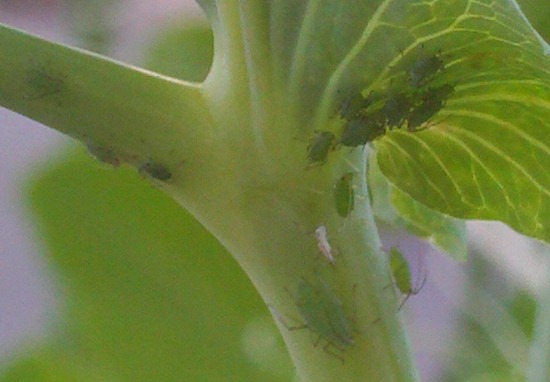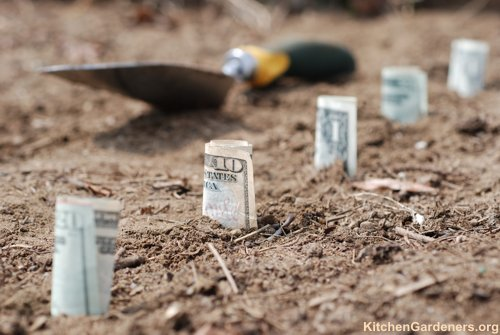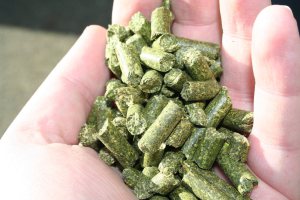Little green bugs on pea plants
13.9 years ago aphids, ladybugs, organic, peas
It is fairly uncommon for me to see these little green bugs on my peas. In case you didn’t guess these are pea aphids, which suck juices from the plant leaves ad spread disease between plants. This is a rare occurrence because normally it is warmer and drier this time of year and we would have our annual ladybug release to take care of these little pests. If the weather holds up we should have good enough weather to do the ladybug release next weekend.
In the meantime I have resorted to to using some organic pesticide solution to deter these pests until the weather gets better. This will not stop the aphids, but hopefully slow the down a little, though when it comes to organic solutions you can not compete with ladybugs which each one can eat up to 5000 aphids/mites in their lifetime. Come next weekend there will be an aphid massacre in the garden. [evil laugh]
Tags: aphids, little green bugs
How to prevent weeds in your garden
14.5 years ago organic, weed prevention, weeds
I doubt there is anyone who enjoys pulling weeds, though now at the end of the season is a great time to do some preventive measures to prevent new growth next season.
Kill your weeds early: The sooner you pull your weeds the easier it is to keep up with them. In addition, if you pick the weeds before the mature and flower and drop seeds you will save a ton of time pulling weeds for every one of those seeds that drop. Call me old fashioned but I normally skip the whole herbicide method and just pull the weeds by hand. Not only does your lawn or garden immediately look better, there is no coming back to see if the weeds need another dose of spray and the whole environmental part of keeping some chemicals out of our water system.
Mulch: This is one I didn’t completely understand until I had been gardening for a while. I for one never have found “beauty bark” beautiful and have always preferred the more natural look and benefits of fertile soil. But that is entirely why you want to use a mulch such as ground bark, straw, pine needles, leaves, newspaper, rubber bark, or even some old carpet. This helps prevent weeds in twp ways. First, it blocks light from the potential little weed seedlings to make their way to the surface. Second, they are not fertile mediums to grow seeds, which is exactly what you are looking for for your large flower beds which like to create good crops of weeds. As a final benefit they help insulate and hold water down for the plants you want to thrive having great growth and eventually shading out those “poor” weed seedlings. just 3-4 inches during the fall and your back should be bending over much less next spring.
If you are thinking, “What about my vegetable garden? I want seeds to be able to grow in there next year.” For your vegetable garden I highly recommend chopped leaves and a vegetable garden mulch. If you happen to have a leaf blower/vacuum that will chop them up all you need to do is empty those bags in a thin 1-2 inch layer across your garden. I used to have one of these though accidentally sucked up a rock which didn’t “chop” well and broke it so the alternate method I use is the following. Bag your leaves throughout the fall and once the leaves stop falling dump them out in a long row in your yard. Then use you lawnmower with bagger attachment and run them over until they are all chopped up. You can also do this more frequently during the fall but I find this a good time to use all the gas in the lawnmower before the end of winter feeling more like I am doing something more meaning other than just letting the mower sit there until it burns off the remaining fuel. With these leaves on the surface you smother any weed seeds and also block out all light to the soil. When spring time comes you simply work in the decomposed leaves into the soil and your garden has a head start with some good organic matter.
Pre-emergent weed control: For some parts of your yard like your lawn mulching is not really an options so to protect against pesky weeds like one of my personally loathing weed, annual bluegrass. Which grows and seeds so close to the ground it is nearly impossible to pull the plants to prevent the spreading. Pre-emergent herbicides is the solution to this problem. Pre-emergent herbicides work by preventing weed seeds from germination by inhibiting cell division in their tiny root system. Given these plants are annuals a successful application can rid you yard of these weeds until they eventually blower over from a neighbors. Pre-emergent herbicides can be purchased as a chemical or the organic method is applying glutton corn meal which normally can be purchased from your local feed store. One thing to remember is that this also will prevent you normal grass seed from germinating as well so be sure to time your application after with with enough lead time to allow the pre-emergent from wearing off.
Grow a cover crop: Growing a cover crop has two major benefits to your garden. Various legumes, grasses, and buckwheat make good options for for cover crops to plants while you garden is empty. First it creates a natural shade from the sun making it hard (or impossible) for seedlings are the surface to survive under their great shadows. Second it provides organic mater as “green manure” to add nutrients to your soil. One recommendation is to make sure you do a little research on the plant you choose as a cover crop, if you accidentally wait too long to “harvest” your cover crop it could go to seed and you may have an entirely new weed problem on your hands.
Cook the soil: When all else fails apply some black plastic (thicker the better) covering to your planting beds and let them “cook” throughout the fall/winter. Like mulch this will prevent any light and most water from entering the areas covered. This will essentially cook the soil killing any weeds, seeds, fungi, or anything else living in that area. Though this is very effective in eliminating weeds and disease from your soil it also kills everything else including good bacteria that your friendly worms like to visit your garden, so you soil may take sometime to recover and return to becoming living soil. I would recommend this method as a last result when the previous methods have proven to be completely unsuccessful.
Just for some positive outlook, you can also think of weeds as green manure assuming you are adding these to your compost, so even out of control they still can decompose and help your garden…
Tags: compost, garden seeds, organic vegetables, outdoor plants, vegetables, worms
Grocery store Vegetables are not as nutritious as they used to be?
15.2 years ago grocery store, organic
“University of Texas, Austin. Davis claims the average vegetable found in today’s supermarket is anywhere from 5% to 40% lower in minerals (including magnesium, iron, calcium and zinc) than those harvested just 50 years ago.”
Not only are those vegetables you been eating at the grocery store less tasty, but may be getting marginal nutritional value. They discuss some of the potential factors in this including use for synthetic fertilizer and the desire to achieve higher yield during a shorter timetable, unfortunately the poor plants do not have time to absorb the beneficial minerals (as do we)
This article is timely with my Chemistry of Gardening — What nutrients do plants need? post. If you have sufficient primary macronutrients (NPK) which is the primary contents on synthetic fertilizer you can still have great yields and fast growing plants but quality of plants are reduced. What the problem appears to me, is the secondary macronutrients are not being supplemented (magnesium, iron, calcium and zinc) which is causing the nutrient/taste deficiency. Organic methods natural provide these nutrients by the addition of organic matter to the soil.
I am cheap and organic vegetables are expensive, this is definitely a case of you get what you pay for. Hope is still here you can easily grow your own organic vegetables at home. If you still think growing your own vegetables is a bad idea here are a list of benefits from buying at the grocery store:
- Continue to rise in cost so you won’t have to worry what to do with your extra money
- No confusion with the small variety available (transport well)
- They don’t taste as good, so no guilt in enjoying eating your veggies
- Less of those pesky minerals for your body to absorb
- Opportunity of getting a trip to the ER after picking up salmonella
In all seriousness this is a scary development where people could be malnourished even with a decent supply of fruits and vegetables.
Tags: cheap, cilantro, organic vegetables, outdoor plants, vegetables
The most profitable plants in your vegetable garden
15.3 years ago cheap, cilantro, garlic bulbs, organic, seedling, seeds, vertical gardening, winter garden
Many vegetables can be expensive to purchase by growing the most expensive vegetables in your garden and buying the least inexpensive vegetables at your grocery store you can easily help drop your food budget. This especially important for people like me with very limited space to grow everything that I consume.
It may be impossible to put a price on the satisfaction of bringing in a basket of produce fresh from your garden. As well as the enhanced flavors from having truly fresh produce from your garden compared to that of your local supermarket. Though when I was harvesting my potatoes this summer with my daughter I did have the thought, Would it have been smarter for me to grow something else in this space? I estimate out of the 4-5 square feet I used for these plants I probably got about $4-5 worth of potatoes.
I did a little research first to determine yields of various plants per square foot and secondly what the value (organic supermarket prices USD) of the yielded produce at harvest. Given I am a city dweller with a fairly small footprint for my vegetable garden (about 30-35 square feet) making decisions on what to buy at the supermarket and what to grow in the garden may be a huge money saver with just a few dollars invested in some seeds for your vegetable garden
Now from the results below you can see the winners for the most produce value per square foot are many of the leafy green vegetables/herbs (cilantro, lettuce, chives, dill, Swiss chard) next comes many of the larger vine plants (tomatoes, squash, pumpkins, peas) with many of the root plants taking up the rear. Now much of this makes sense where many of the vine plants grow on trellises and are allowed to spread, which I guess is sort of cheating the square foot rule but I will let it slide. Compared to the root plants whose production is entirely dependent on the space allowed in square footage they have to grow as well as these are normally inexpensive produce items to begin with.
| Vegetable | USD Value/SF |
| Cilantro | $ 21.20 |
| Arugula-Roquette | $ 20.92 |
| Green Salad Mix | $ 17.55 |
| Chives | $ 16.40 |
| Dill | $ 16.40 |
| Lettuce | $ 16.20 |
| Tomato, Cherry, small & medium | $ 15.57 |
| Turnip | $ 9.90 |
| Tomato, large | $ 9.50 |
| Squash, Winter | $ 8.40 |
| Tomatillo | $ 8.00 |
| Cucumber | $ 7.74 |
| Basil | $ 6.63 |
| Radish, Red | $ 6.22 |
| Pumpkin | $ 6.20 |
| Chard, Swiss | $ 6.14 |
| Celery | $ 6.00 |
| Squash, Summer | $ 5.96 |
| Choi | $ 5.70 |
| Peas, Snow | $ 4.50 |
| Pepper, Jalapeno | $ 4.50 |
| Squash, Summer, Zucchini | $ 4.17 |
| Onion, Bunching | $ 4.14 |
| Pepper, Bell | $ 3.60 |
| Brussels Sprouts | $ 3.59 |
| Carrots | $ 3.56 |
| Rhubarb | $ 3.25 |
| Squash, Winter, Butternut | $ 3.20 |
| Kale | $ 3.07 |
| Grass, Lemon | $ 3.00 |
| Peas, English | $ 3.00 |
| Onion, Bulb | $ 2.63 |
| Radish, White | $ 2.60 |
| Bean, Bush | $ 2.51 |
| Peas, Edible Pod | $ 2.50 |
| Artichoke, Globe | $ 2.40 |
| Cabbage, Chinese Napa | $ 2.24 |
| Squash, Winter, Delicata | $ 2.10 |
| Spinach, Spring/Fall | $ 1.80 |
| Leeks | $ 1.75 |
| Potatoes | $ 1.50 |
| Parsnips | $ 1.50 |
| Garlic | $ 1.37 |
| Squash, Summer, Yellow | $ 1.34 |
| Parsley | $ 1.31 |
| Corn | $ 1.25 |
| Squash, Winter, Acorn | $ 1.20 |
| Squash, Winter, Hubbard | $ 1.20 |
| Eggplant | $ 1.10 |
| Greens, Mustard | $ 1.10 |
| Rutabaga | $ 1.00 |
| Beet | $ 0.89 |
| Cabbage, Savoy | $ 0.80 |
| Broccoli | $ 0.80 |
| Kohlrabi | $ 0.75 |
| Cauliflower | $ 0.60 |
| Broccoli, Chinese | $ 0.60 |
| Cabbage | $ 0.50 |
Sources: http://www.mcgoodwin.net/pages/ppatch.html for plant yield information, http://shop.safeway.com for current produce prices
Now even with this information I will still plan on growing some onions and garlic since I more than likely would be forced to use dehydrated alternatives due to being too lazy to drive to the supermarket to buy fresh varieties. Though I may be adding some more herbs/greens to my garden this year.
One important thing to remember is you still have to eat the vegetables, throwing $20 worth or arugula or cilantro into the compost bin is not exactly a sound investment. You can also get higher yields by growing vertically, but don’t forget those tall plants produce a larger shadow so you may still need some extra ground space to support these alternate growing methods.
So go out and get some cheap vegetable seeds (or in many cases free) and plant some profitable vegetables in your backyard/patio garden this spring.
Tags: cilantro, compost, garlic bulbs, herb garden, organic vegetables, outdoor plants, pepper plants, tomato plants, vegetables
Using alfalfa pellets as cheap organic fertilizer for your lawn and garden
16.2 years ago alfalfa pellets, cheap, fertilizer, organic
We all know if you walk into a grocery store the organic produce is always more expensive than produce grown using non-organic methods. Using deductive reasoning it seems easy to determine that this would mean growing vegetables organically will cost me more than if I used non-organic methods. What is a cheap vegetable gardener to do?
One disadvantage (and advantage) to organic fertilizer is that it is not as potent as chemical fertilizers. So my 2 lbs of organic will not nearly go as far (at least short term) as the same amount of chemical fertilizer. One trick to being cheap is to purchase products that are not being marketed for your planned purpose. So to solve my expensive fertilizer issue I used this same logic to solve the problem of finding a location to buy organic fertilizer that was not marketed as “fertilizer.” After some research I determined a source from my local feed store. For $10 I was able to get 25 lbs of alfalfa pellets compared to 2 lbs of alfalfa meal at my local nursery for around the same price.
One great thing about using organic fertilizer is my kids can help spread it around, unlike chemical fertilizers. It also contains triacontanol which is a root growth stimulant along with plenty of organic matter to help boost some extra microbial activity. This not only helps the grass but also improves your soil at the same time. By taking a few cups of alfalfa pellets and mixing with water you can also make alfalfa tea, which I am planning on doing later but will sure to let you know how it works out. One more tip, make sure you distribute the alfalfa pellets before a big rain or watering, currently my lawn looks like some geese are using it as their bathroom.
Tags: alfalfa pellets, cheap, organic vegetables, vegetables





